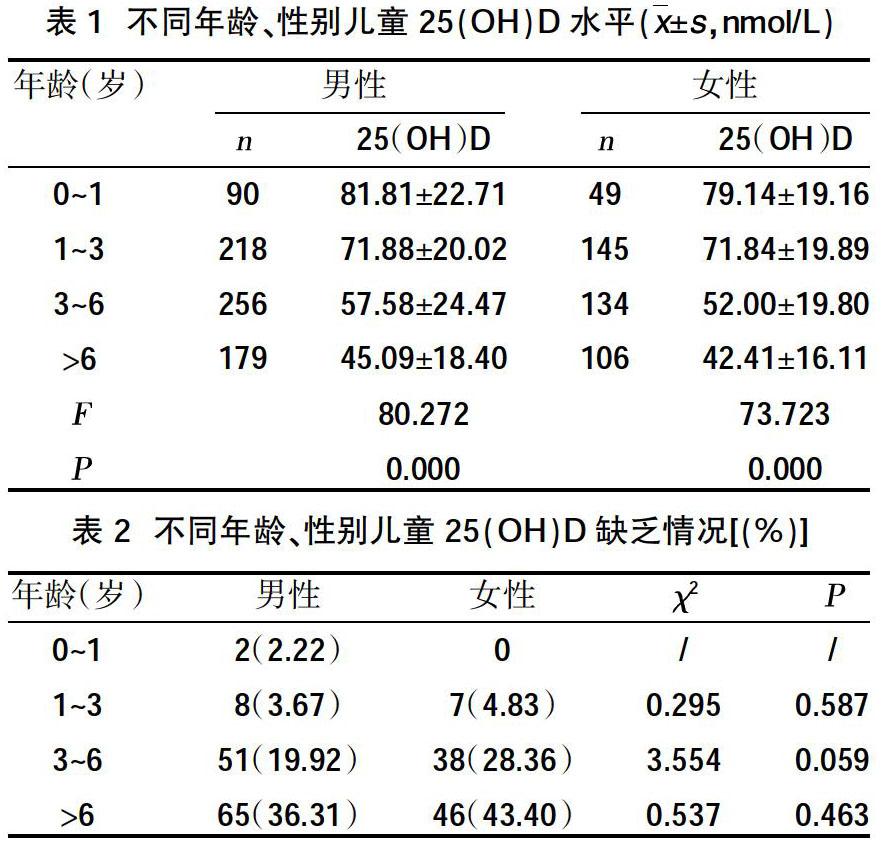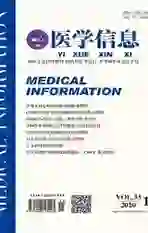成都市健康体检儿童25羟基维生素D水平分析
2020-09-06王春远刘成桂
王春远 刘成桂


摘要:目的 了解成都市某三甲醫院健康体检儿童维生素D状况,为临床合理补充维生素D提供理论依据。方法 回顾性分析2016年12月1日~2019年2月29日在成都市妇女儿童中心医院体检并进行常规血清25羟基维生素D检测的儿童,采用ADVIA centaur XP 全自动化学发光免疫分析仪以化学发光方法分析不同年龄、性别及季节健康体检儿童的血清25羟基维生素D水平。结果 ①儿童血清25羟基维生素D水平为(60.83±24.30)nmol/L,女性儿童25羟基维生素D水平为(59.35±23.24)nmol/L,男性儿童25羟基维生素D水平为(61.70±24.87)nmol/L,其中18.44%的儿童存在25羟基维生素D缺乏,16.91%的儿童存在25羟基维生素D不足,64.66%的儿童25羟基维生素D处于正常水平。②不同年龄儿童的25羟基维生素D缺乏率随着年龄的增加而增加,<1岁龄儿童25羟基维生素D缺乏率最低,>6岁儿童25羟基维生素D缺乏率最高,差异有统计学意义(P<0.05)。③不同季节儿童25羟基维生素D缺乏率不同,其中冬季最高,其次为春季和秋季,夏季最低,差异有统计学意义(P<0.05)。结论 成都市儿童25羟基维生素D存在不同程度的缺乏,且存在年龄季节和性别差异。建议相关部门定期监测儿童25羟基维生素D水平,合理补充维生素D,促进儿童健康发育。
关键词:25羟基维生素D;化学发光法;维生素缺乏;维生素不足
中图分类号:R153.2 文献标识码:A DOI:10.3969/j.issn.1006-1959.2020.15.041
文章编号:1006-1959(2020)15-0133-03
Abstract:Objective To understand the vitamin D status of children in a health checkup in a tertiary hospital in Chengdu, and provide a theoretical basis for clinically reasonable vitamin D supplementation.Methods A retrospective analysis of children who had a physical examination and routine serum 25-hydroxy vitamin D test at Chengdu Womens and Childrens Central Hospital from December 1, 2016 to February 29, 2019 was performed using the ADVIA centaur XP automatic chemiluminescence immunoassay analyzer for chemical analysis. Luminescence method was used to analyze the serum 25-hydroxy vitamin D levels of children of different ages, genders and seasons during physical examination.Results ①The level of 25-hydroxy vitamin D in childrens serum is (60.83±24.30) nmol/L, the level of 25-hydroxyvitamin D in female children is (59.35±23.24) nmol/L, and the level of 25-hydroxy vitamin D in male children is (61.70±24.87) nmol/L among them, 18.44% of children had 25-hydroxy vitamin D deficiency, 16.91% of children had 25-hydroxy vitamin D deficiency, and 64.66% of children had 25-hydroxy vitamin D at a normal level.②The 25-hydroxy vitamin D deficiency rate of children of different ages increases with age. The 25-hydroxy vitamin D deficiency rate of children <1 year old was the lowest, and the 25-hydroxy vitamin D deficiency rate of children> 6 years old is the highest, the difference was statistically significant (P<0.05).③The 25-hydroxy vitamin D deficiency rates of children in different seasons were different, with the highest in winter, followed by spring and autumn, and the lowest in summer, the difference was statistically significant (P<0.05).Conclusion There are varying degrees of deficiency of 25-hydroxy vitamin D in children in Chengdu, and there are differences in age, season and gender. It is recommended that relevant departments regularly monitor children's 25-hydroxy vitamin D levels, and reasonably supplement vitamin D to promote healthy development of children.
此外,维生素D的缺乏存在年龄差异[12,13]。本研究结果显示,无论是男性儿童还是女性儿童,6岁以上儿童的缺乏率最为严重,>6岁的儿童25(OH)D缺乏率在男性儿童和女性儿童分别为36.31%和43.40%。0~1岁龄儿童25(OH)D缺乏率最低,仅为2.22%(男性儿童)和0(女性儿童),这可能与本研究样本量较少,特别是女性儿童较少有关。我国目前儿保规定婴儿在出生后2周开始补充维生素D至2岁。这就促使人们忽略了后期儿童维生素D的补充。维生素D对儿童身体健康发育具有重要作用,它可以促进成骨形成,并预防儿童佝偻病的发生。因此充足的维生素D对儿童的身体健康以及发育尤为重要,应引起足够的重视。但目前我国尚缺乏大规模多中心,多年龄层次的儿童维生素D水平的调查研究。因此,本研究分析了我院0~18岁儿童的维生素D状况,对临床合理补充维生素D具有指导意义。
儿童维生素D的缺乏亦存在季节差异,本研究结果显示,不同季节儿童25(OH)D缺乏率不同,夏秋季儿童25(OH)D缺乏率最低,分别为9.98%和12.67%。冬春季节儿童25(OH)D缺乏率则较高,分别为29.21%和26.93%,这与已有报道基本一 致[14,15]。这可能是由于夏秋季成都太阳照射比较多,儿童参加户外活动也相对较多,通过太阳照射而获得的维生素D也较多。而冬春季节成都地区阴雨天气比较多,这使得通过阳光照射产生维生素D的途径缺失,这也提醒儿童家长应该在冬春季节适量增加维生素D的补充。
目前维生素D缺乏是世界范围内普遍存在的问题,成都地区由于其特殊的地理气候特点,维生素D缺乏更为严重,特别是>6岁的儿童。儿童的青春发育期是人体迅速生长发育的关键时期,也是继婴儿期后人生第二个生长发育的高峰期,因此,大龄儿童维生素D缺乏的后果同样严重,大年龄儿童的维生素D的补充也应引起高度重视。此外,医务工作者也应做好广泛的宣传教育工作,积极开展各年龄段维生素D补充剂量的科普知识宣传工作,使维生素D 的补充剂量科学、合理。
参考文献:
[1]McCollum EV,Simmonds N,Becker JE,et al.An experimental demonstration of the existence of a vitamin which promotes calcium deposition[J].J Biol Chen,1922,53(1):293-298.
[2]Goltz Man D.Function of vitamin D in bone[J].Histochem Cell Biol,2018,149(4):305-312.
[3]Haimi M,Kremer R.Vitamin D deficiency/insufficiency from childhood to adulthood: insights from a sunny country[J].World J Clin Pediatr,2017,6(1):1-9.
[4]Wang L,Wang H,Wen H,et al.Relationship between HOMAIR and serum vitamin D in Chinese children and adolescents[J].J Pediatr Endocrinol Metab,2016,29(7):777-781.
[5]Ekbom K,Marcus C.Vitamin D deficiency is associated with prediabetes in obese Swedish children [J].Acta Paediatr,2016,105(10):1192-1197.
[6]李秋實,仰曙芬.维生素D缺乏与儿童代谢综合症的研究进展[J].中国儿童保健杂志,2016,24(4):381-383.
[7]乔阳,王颖,白增华,等.血清25-羟维生素D水平对儿童免疫功能的影响[J].中国优生与遗传杂志,2014,22(9):165-166.
[8]仰曙芬,吴光驰.维生素D缺乏及维生素D缺乏性佝偻病防治建议解读[J].中国儿童保健杂志,2015,23(7):680-683.
[9]章建伟,王卓英.0-9岁儿童维生素D水平的调查[J].浙江预防医学,2015,27(3):229-231.
[10]吴光驰.维生素D缺乏离我们有多远[J].中国妇幼卫生杂志,2014,5(3):72-75.
[11]朱庆龄,陈俊伟,林卫华,等.泉州地区0~12岁儿童25羟维生素D水平分析[J].中华实用儿科临床杂志,2018,33(11):842-845.
[12]邵小飞,郑娟,刘杰.1309例 0-7岁儿童25-羟基维生素D水平分析[J].中国妇幼卫生杂志,2015,6(3):26-29.
[13]夏黎,崔县伟,王玉,等.南京地区0-5岁儿童25-羟基维生素D水平及其与季节的关系[J].中华实用儿科临床杂志,2015,30(19):1470-1472.
[14]邓红岩,蔡婧晔,侯江婷,等.张家港市2942例婴幼儿25-羟基维生素D水平现状分析[J].现代预防医学,2018,45(16):2954-2957.
[15]孔锐,宋媛,叶侃,等.苏州市0-6岁儿童骨密度调查及其与25羟基维生素D关系研究[J].中国骨质疏松杂志,2018,24(9):1219-1224.
收稿日期:2020-06-27;修回日期:2020-07-06
编辑/成森
